Menus
- Pure water word fun
- Discovery
- SX-R
- STX-15F
- Ultra LX
- Ultra 310LX
- In action
- Conclusion
- Availability / Prices
Pure water word fun
Historical producer of the first Jet Ski, Kawasaki invites us to test its nautical range on the occasion of the comeback of one of its legendary machines, crowned with numerous championship victories: the SX-R.
From their real personal watercraft names, "sea scooters" are often called by the name given by their brand.. Terms so widely used that they become generic and designate them in the broad sense. Let’s restore their origins, starting with the first of them, the Jet Ski from Kawasaki, then the Sea-Doo from Bombardier and WaveRunner from Yamaha. The origin of these machines is revealed to you in the History and Technical article..
They are therefore the descendants of the JS 400, the first nautical vehicle of its kind, a "hand-held" scooter marketed in 1973 by Kawasaki. After many evolutions, the Akashi brand also produces "saddle" machines, much easier to access for the general public, with the popular success that we know. More demanding, the last version of the original model appeared in 2003 for the 30 years of Jet Skiing. Called 800 SX-R and presented as easier to handle, more stable, it disappeared in 2007, defeated by ecological standards chasing its two-stroke engine of 782 cm3. Five "saddle-mounted" Jet Ski now remain in the range, the STX-15F, Ultra LX, Ultra 310LX, Ultra310 and Ultra310X.
But 2017 also sees the big return of a "hand-held" jet, the SX-R. It is around Toulouse that we take the controls of the Kawasaki Jet Ski, on a good-sized body of water, guarded by the chain of snow-capped Pyrenees barring the horizon. Gorgeous.

Discovery
Yes, but what do motorcycles have in common? Well, first of all, this clever alchemy of performance, balance and fun. But more precisely here, Kawasaki powers all its Jet Ski with the engine of one of its sports motorcycles, the ZX12R…. In suitable forms of course and even with a TVS type compressor, like a Mustang! The machines then deliver 152 to 300 hp. These machines also give way to ever more important technology. Depending on their level, there are digital display instrumentation, audio system, learning modes and power reduction by electronic keys, electric trim correction and electronic throttle control. In short, modern machines like our motorcycles.
Besides, let’s talk quickly technical. The mechanics are therefore a four-cylinder in-line of 1,498 cm3, double ACT and 16 valves. Admission is entrusted to 60 mm butterflies. With a bore ratio of 83 x 69.2 mm, the increase in displacement is produced by the stroke. The liquid cooling is done by the water captured by the turbine, forcing at sea to purge the circuit with fresh water after use. The Ultra 310 LX, Ultra 310 R and Ultra 310 X models are equipped with a TVS-type air exchanger and supercharger, which takes power to 300 hp (221 kW). The crankshaft drives, in direct drive, a turbine to propel the machines. This means that the Jets are already in motion, very slowed down, from the start of the block.
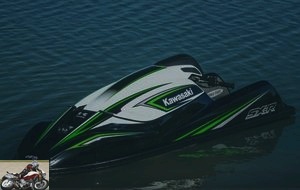
SX-R
Let’s take a quick overview of the forces currently present on the meadow, sorry, the body of water. To discover the range, let’s start with the SX-R, an event product, evoking the heyday of the segment and Kawasaki success. The development of its new hull was made according to the feedback obtained in competition. Racy, narrow, sporty, THE original Jet Ski appears in a most seductive form. However, compared to the previous version, the new SX-R is widened (+30 mm) and lengthened by 400 mm in order to gain stability both in a straight line and in curves. Thus, the speed of passage in curve is increased and the holding of course higher. In addition, the stability of the hull should make it easier to get on board..
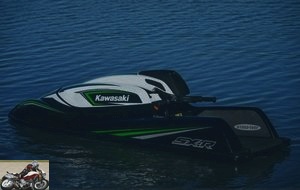
When the arm is resting on the hood, the craft appears to be a mixture of the streamlined porpoise and the torpedo. Taut lines chisel the upper hull, forming flat aerodynamic surfaces that run towards the sides and come to a shoulder towards the stern. The rear space is lined with non-slip surfaces and, unheard of on this type of machine, two indicator lights (engine status and changeover to reserve) integrate the top of the steering arm. Evolution of that of the SX-R 800, this directional appendage allows to absorb the increase in power and top speed. Its axis has been positioned to reduce the back and forth movements of the handles and limit the pilot’s efforts, especially during long races. Typed cross, the handlebars topped with a foam cylinder also look after the race side. It controls the movements of a directional die-cast aluminum nozzle, designed specifically for the SX-R. Its 87 mm diameter and 102 mm long cone claims an optimal design for this segment. The water intake is via a stainless steel inlet whose elongated design is based on that which fitted the previous model..

The throttle is controlled by a trigger on the right index finger. And its 1,498cc engine makes it the most powerfully accelerated hand-held jet ski on the market. The machine develops 152 hp, almost double the 800SX-R of 2003. If the maximum speed differential is not very meaningful, 96 km / h against 76, acceleration is beyond measure. Especially since the SX-R admits only 280 kg all full facts. To give an idea of the sporting potential, on a 50 meters standing start, the novelty leaves its predecessor 19 m behind! It also relegates the Ultra 310R and its 300 hp at 5 pitches…. It can also be limited to 120 units to escape the sea tax. The maximum torque is 14.4 da.Nm. Note that, from its first competition with Team Pastorello Competition, the SX-R won the victory thanks to pilots Raphael Maurin and Jean-Baptiste Botti.
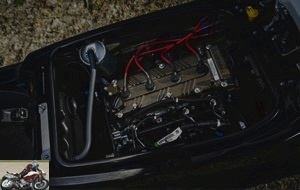
The hull also benefits from numerous equipment aimed at improving efficiency. Thus the new Jet Kawa has the Kawasaki Splash Deflector (KSD). Unique on this type of machine, a side strip on the front part of the hull reduces splashing water during acceleration and in eddies.
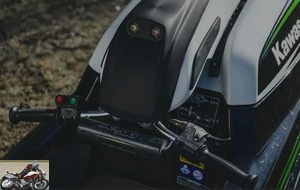
STX-15F
Alongside this sporty ghost are three saddle-type jet skis; the STX-15F, entry-level product from Kawasaki, the Ultra LX which makes the junction with the top of the range Ultra 310LX. Let’s start with the "little" scooter. Less "stylish" than its colleagues, the STX-15F retains a more discreet and all the more elegant aesthetic. Thus, its rounded and fluid front face, surmounted by a tapered hood, more reminiscent of dynamic boating than outrageous mechanical sport..
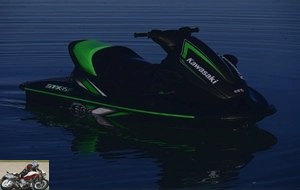
Less plush than its congeners, it takes all the same without difficulty 3 people on its long and wide saddle. Comfort is also the standard on Kawasaki machines. Removable the rear seat allows access to a generous storage box and an extinguisher holder. The space between the seat and the edge of the hull provides good reception for the feet and the aft platform makes it easy to get on or off the boat..
Recalling those of some current scooters, the cockpit accommodates an LCD screen.

Dedicated to a wider audience, scooters are more technological. Two electronic keys allow you to modify the power to facilitate learning. The machine delivers 152 hp and 100 in the flanged version and the maximum torque is 15.2 da.Nm. High performance, the turbine generates very low cavitation to optimize acceleration and deliver maximum thrust. Contents, the weight of the STX-15F is displayed at 383 kilos ready to sail.
Ultra LX
Particularly stylish, the Ultra LX is more reminiscent of Formula 1 and competition. Its long, sharp hood covers fake air inlets with an aggressive look. Welcoming, it is a mixture of sportiness and comfort and easily accommodates three people on its long "LXuryseat" saddle, a variant with backsplashes, for comfortable excursions. Ergonomic when seated, the beads can compress under the weight to prevent the pilot from rolling back during strong acceleration. In rough seas, they can sit on the backsplash to let the thick padding absorb shocks and put less strain on the leg muscles.
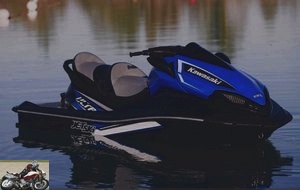
The Ultra LX has an adjustable handlebar in 5 positions to adapt to multiple riders and riding styles, also allowing standing or seated riding. A liquid crystal screen groups together the instrumentation, displaying driving modes, water and air temperature, clock, stopwatch, hour totalizer, tachometer and maximum speed.
The machine is also equipped with KSS (Kawasaki Smart Steering) assistive steering assistance, designed to help novice riders in learning turns and maneuvers. Not very intrusive, the system should not be felt by more experienced pilots.
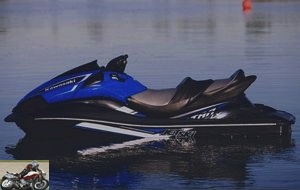
Also the intelligent learning mode SLO (Smart Learning Operation), allows to electronically reduce maximum power and speed. Beginners can thus become more comfortable with the vehicle before testing its full power. This is 152 hp for a couple of 14.4.da.Nm
Its aft deck is larger and wider and two handles allow you to either hold on while sailing, or get back on board more easily. In the catalog since 2008, the Ultra LX 2017 displays more generous dimensions, taking the hull of the superior model, the Ultra 310LX. The thickness of the shell has been changed to optimize areas of stiffness and make the whole thing lighter. The full weight now drops to 462 kg. Under the bow, recesses called KSD (Kawasaki Splash Deflectors) allow the splash forward to be deflected. A fourth deflector covers the first three to limit projections in fast bends.
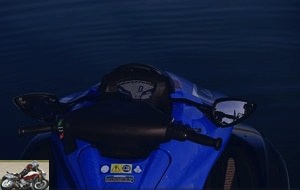
Finally, sponsons (stabilizers) protrude from the hull in order to stabilize it in a straight line (in particular to limit porpoising during departures). In addition, they make the Ultra LX more maneuverable when changing course, especially at high speed..
Ultra 310LX
Here is now the pinnacle of the Kawasaki Jet Ski range, the luxurious and powerful Ultra 310LX. Present since 2011, it ostentatiously displays its dynamic and comfortable claims. We find the aesthetics of the Ultra LX model, but taken to a higher level. Thus, the hood is adorned with chrome attributes on its grille and the top of the cockpit. It is also equipped with a Jetsound on-board audio system. Original equipment of the Ultra 310LX, it includes a controllable handlebar assembly and two speakers placed below the mirrors. The amplifier develops 20 to 40 W maximum on 2 channels, the speakers deliver 30 to 60 W each. As a good sporty sea sedan, the Ultra 310LX has a waterproof glove box which contains the connectors to ensure sound. The system is therefore compatible with iPod, iPhone and most smartphones and other audio players equipped with a stereo "jack" output. It also plays music files from a USB stick.
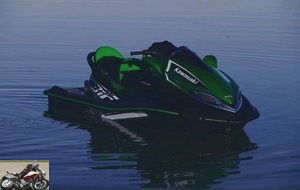
The seats are also identical to that of the Ultra LX as is its adjustable handlebars in 5 positions. The liquid crystal display groups together the instrumentation, displaying driving modes, water and air temperature, clock, stopwatch, hour totalizer, tachometer and maximum speed.
Its 22.5 ° opening V-shaped hull reduces lateral G-grip during tight turns for better piloting efficiency. This profile also prevents spinouts during tight turns.

More technological than its Kawa colleagues, the Ultra 310LX has electronic throttle control to better manage the power of its compressed engine. Because the four-cylinder with its TVS-type supercharging develops 300 hp here! Engine modes also control this bloated cavalry and also offer a reduced speed which maintains the engine speed at 8km / h in order to respect the legal speed of restricted areas..
Sport requires, the Ultra 310LX embeds an electric trim correction. This device makes it possible to modify the angle of the nozzle (over a continuous adjustment range of +/- 8 ° from the normal position), making it possible to easily adapt the trim of the hull to the sailing conditions and to the style. piloting. On heavy seas, the nozzle is oriented upwards to raise the bow; in calm waters, the downward tilt lowers the bow for better cornering performance. Of course, the machine is also fitted with KSS (Kawasaki Smart Steering) auxiliary steering assistance..
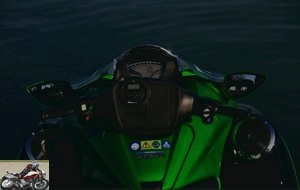
In action
It is a nine-time world champion of jet-ski, Jean-Bruno Pastorello and his team of recent winners on the handlebars of the SX-R which accompanies our evolutions. Rather experienced in wheeled machines, I am almost new to nautical motorcycles. And all the more so in a hand-held jet. The lake offers a varied course, mixing straight lines, loose and tighter curves..
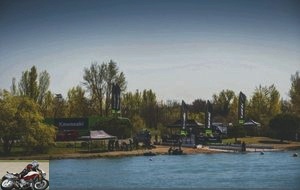
It is with the STX-15F that I deny myself motorbike-nautically speaking. The machine gives you confidence through its contained dimensions. As with all these amusement machines, the handling is simple. Much more than that of a motorcycle. No speed, no balance to manage and…. no brakes. Contact. The underwater ZX-12R starts up discreetly and the machine slowly moves away from the edge to reach the authorized space. Gas ! Moderate all the same. Having done two laps with our world champion, I quickly understood that the operation requires a little experience before going fast. Basically, 4 laps are enough to understand the reactions of an already very powerful and above all very agile machine. The experience of two-wheelers on the circuit is also a help to pass quickly in curves, without releasing the trigger. The contained glide and relaunch effect is impressive. Just like the centrifugal force which sometimes fails to throw me off on a choppy water taken askew. I am less comfortable in super tight turns which require more engagement on the handlebars and exceed my beginner level. But, there too, the go-around catapulted the STX-15F forcefully towards the next buoy. Another learning point for a biker, the trajectories are more sliding types and the markers-buoys must obviously be circumvented…. One thing in common, the gaze is also of capital importance to ensure a high-performance course..

For a motorcyclist, the logical absence of brake is less of a hindrance than that of steering when you cut the throttle. A jet ski needs the force of its turbine to spin, directing the flow through its steering nozzle. Otherwise, we continue straight on. A good reminder to anticipate slowdown and trajectory.

The Ultra LX is now waiting for me. Longer and wider, this model is the "family" sedan. It turns out to be more stable than my previous mount, but also a little less manoeuvrable; its superior inertia is noticeable when cornering, but the performance remains just as convincing. Especially since the machine absorbs waves better and allows, even with little experience, to maintain a higher speed than with a more compact machine. Quite close to the STX-15F in dynamic capacity, the Ultra LX loses in fun what it gains in handling comfort. Its 152 hp largely motorize its volume, but that can well give the double of cavalry?
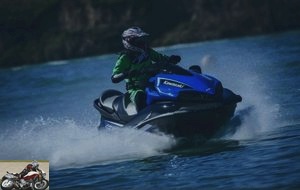
And many extraordinary sensations. And performance surely too important to leave the controls to all comers. Because the Ultra 310LX’s acceleration is mind-boggling, allowing a top speed of 130 km / h! But more than pure speed, it’s the thunderous raises and that feeling of endless strength that impress. More sporty, the maxi jet-ski is also more sensitive in throttle control and requires skill. A true sea dragster, it requires an experienced tamer to avoid jerks and spin efficiently. Its compressor gives it a force available at any speed, without hollow zone. On board, everything is surprisingly more subdued. Sharing its hull with the Ultra LX, the high-end Kawasaki jet-ski here shows the relevance of its hydro-dynamic equipment. Sponsons and leveling control give superior precision to the Sport Jet. Stable at all times and at any speed, the Ultra 310LX allows trips at very high speed without forcing and in surprising comfort. And if you want to evolve in rhythm, the sound system is largely powerful and of quality.
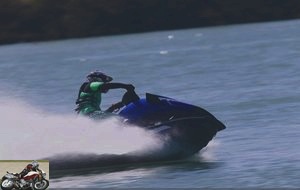
It’s a whole different machine that I finally approach. Because the Kawasaki SX-R has little in common with its saddle cousins than its Jet Ski surname and its mechanics. Getting started requires real learning, between skiing and riding a bike. That is to say the conceptual bases of the original project. It is therefore necessary to balance and understand the supports necessary for the good use of the hand jet. And that takes either a certain time or a certain time, depending on the pilot. Even at a standstill, the machine heels nicely. And yet, its stability is much better than that of the pioneers. How can we first invent this machine in a vertical position before its seated variation? ?
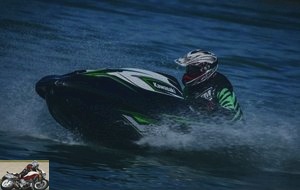
The first phase of control is done on your knees, to feel and understand the movements. Then, like a child, we try the squatting position, then squatting-standing, then standing and…. at the water. Extremely manoeuvrable and responsive, the SX-R is a thoroughbred whose kicks invariably throw you off guard. But I am tenacious and will manage to stand up, to turn more or less, but without yet controlling the machine. Frustrating, but exciting, the sporting potential and freedom of movement pushes to come up again and again on the backbone of the mechanical porpoise. One of the secrets is to keep a steady speed. And on the index, it is not easy at first. We would like more progressive leverage. But work always pays and allows the student to progress. I see all the potential of the SX-R, the pleasure of taking an angle and relaunching with force. Because here, the 152 horses drive only 280 kilos (more than 380 for the lightest of the saddle jets)…. Something to wake up / dry the wet rider on the handlebars.

Conclusion
This handling of the Kawasaki Jet Ski range and in particular the SX-R, allows you to appreciate the use of a motorcycle mechanic for nautical use. We also find sensations sometimes quite similar to those of our tire mounts. Pure creations of pleasure, saddle scooters are affordable by all, so easy to use. And misleading. Their mastery requires a real learning to navigate in frequented waters, let alone the most powerful. Rather dedicated to short or dynamic outings, the STX-15F is the versatile jet, able to accommodate three passengers while remaining fun. More robust, the Ultra LX makes it possible to sail far with more comfort, like a powerful sedan. With the Ultra 310LX, a sports wagon is available to you. Plush, comfortable, efficient and masterfully motorized, the Hyper Jet Ski is a sensational machine, in the first sense of the word..
Less obvious, the SX-R requires this mastery for its use. The relative complexity of its handling is matched only by the multiplicity of sensations it delivers to the diligent and passionate pilot. Less easy on board, it then turns out to be much more interesting. A real word-water for lovers of fiery freedom.
Availability / Prices
- SX-R
152 hp version: 10,499 €
120 hp version: € 10,799 - STX-15F
152 hp version: 10.299 €
100 hp version: € 10,599 - Ultra LX
100 hp version: 13,099 €
152 hp version: € 12,799 - Ultra 310LX: € 21,299
Related articles
-
Versys 300 and 650, Vulcan, Ninja 400 and 650, Z650 and Z900, from 300 to 900, from 5,000 to 9,000 €, 7 machines for the new A2 licenses Trail, sport,…
-
Kawasaki Ninja 125 and Z125 comparison test
Dreams of big children 4-stroke single cylinder, 125 cm3, 15 hp and 11.7 Nm, 146 kg full made, from 4,599 euros The 125 cm3 motorcycle segment is an…
-
Ultimate. Phrase taken from Latin: Highest degree, unsurpassable, which is best… Insane, incredible, breathtaking … There are no qualifiers to…
-
998 cm3, 210 hp at 13,000 rpm, 11.3 m / kg, 300 km / h, 206 kilos, € 17,799 Breathtaking performance, cutting-edge electronics, pure feel… You may not…
-
Suzuki Gladius 650 SFV vs Kawasaki ER-6N motorcycles comparison
Suzuki Gladius vs Kawasaki ER6 comparative test The Gladius is the new Suzuki 2009, directly derived from the SV: a V-Twin of almost 70 horsepower come…
-
Comparison customs Kawasaki VN 900, VN 1700 and W800
Three customs for one choice Second custom seller in France, after Harley Davidson of course, Kawasaki has an extensive range. To understand the…
-
4 cylinders in line, compressor, 998 cm3, 210 hp at 11,000 rpm, 137.3 Nm at 9,500 rpm, 260 kilos, € 21,999 Kawasaki reinvents the super-fast and…
-
KTM 790 Adventure and Adventure R motorcycle comparison test
New icon, Easy Adventure 95 hp at 8,000 rpm and 89 Nm at 6,600 rpm KTM, it was the master of the single cylinder, then of the maxi trail but was absent…
-
The Z ReviZitee From the top of its eleven Z’an, the Z rolls mechanics and adopts a new look which is scary . For this new model, the manufacturer…
-
Kawasaki ZX10R motorcycle test
The motorcycle division of the giant Kawasaki industry, is only a drop in the sea, but that does not prevent it from being a major player in the world of…